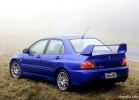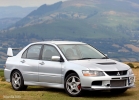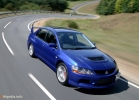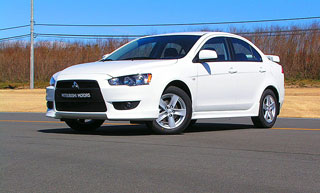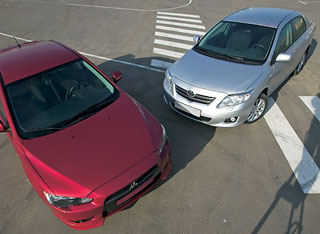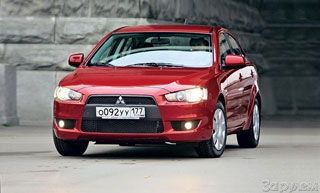Test drive Mitsubishi Lancer Evolution IX 2005 - 2007 sedan
The burden of popularity
For prevalence in the Russian market, Mitsubishi-Lenser was nicknamed Japanese Lada. The spiteful critics saw in the nickname a sharp hint of low reliability. Igor Kozlov is ready to argue with them.STAR FEVER
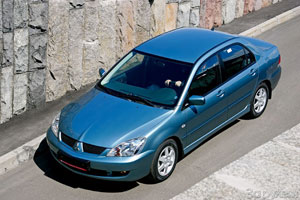 For several years, the ninth generation model remained the leader in sales in the Russian market. Only in 2006, she lost positions due to restrictions on deliveries in the second half of the year by 40% (the plant was preparing to switch to the release of tenth-generation lanser). However, the purebred Japanese sold by the circulation of 47,000 copies lost only to domestic foreign cars-Ford-Focus and Reno-Logan.
For several years, the ninth generation model remained the leader in sales in the Russian market. Only in 2006, she lost positions due to restrictions on deliveries in the second half of the year by 40% (the plant was preparing to switch to the release of tenth-generation lanser). However, the purebred Japanese sold by the circulation of 47,000 copies lost only to domestic foreign cars-Ford-Focus and Reno-Logan. Those who wish until the end of this year can buy a new car, they are still being produced. To whom it is not even modest, with a 4G13 (1.3 l) engine, the equipment is invite (Invite) for 339,000 rubles. ($ 14,890) - road to the secondary market, where there are more than enough offers. About $ 10,000 are asked for cars from the first parties, three -year -olds are sold from $ 11,000, and the one -year -old car - from $ 13,000.
Cars from the Asian markets come across extremely rarely, but they are not from Europe at all. In the European Union, the Lancers are not popular - it is obvious, therefore, they did not even conduct a Crash test in the framework of EURONCAP. The Australian ANCAP (analogue of EURONCAP) awarded Ulan with only three stars: 10 points from 16 for a frontal blow, as much for the side. A similar picture of the American NHTSA, despite the difference in the methodology (hit in a hard barrier with a 100%overlap at a speed of 55 km/h) - four stars of seven possible. A weak place when hit is the floor, but there are no complaints about the body in the regular operation. Corrosion bypasses it, doors do not sag, and the interior elements remain silent for a long time. But not all.
TREBLE CLEF
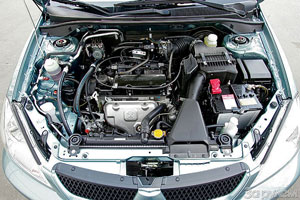 Over time, the voice of the glove compartment is cut through. You can plug the talker with a simple bending of the ears. Another cricket can settle in the windshield area; It is expelled with a sink of the opening. The main violin duet enters after 15-20 thousand km-in the silent blocks of levers and suspension springs. At the end of 2004, the plant fired the first violin himself, having finalized the silent blocks, and our craftsmen learned to jam the second, putting a piece of hose on the lower turns of the spring. However, such gaskets are quickly abrasion. You can get rid of the creak more radically - by installing springs from a two -liter modification. If the racks were disassembled, along the way we change the supporting bearings, even if the steering wheel rotates easily. Their resource in our conditions (dirt, chemical regents) is small.
Over time, the voice of the glove compartment is cut through. You can plug the talker with a simple bending of the ears. Another cricket can settle in the windshield area; It is expelled with a sink of the opening. The main violin duet enters after 15-20 thousand km-in the silent blocks of levers and suspension springs. At the end of 2004, the plant fired the first violin himself, having finalized the silent blocks, and our craftsmen learned to jam the second, putting a piece of hose on the lower turns of the spring. However, such gaskets are quickly abrasion. You can get rid of the creak more radically - by installing springs from a two -liter modification. If the racks were disassembled, along the way we change the supporting bearings, even if the steering wheel rotates easily. Their resource in our conditions (dirt, chemical regents) is small. In principle, the creak on the performance of suspensions does not affect, but faulty shock absorbers will seriously worsen controllability. The first problems with them, as with the racks of the reptile stability stabilizer, can occur already by 30 thousand km. The dealer, as a rule, changes only faulty, but we recommend that the shock absorbers are updated with a couple. And do not forget to check the angles of installation of the rear wheels - the behavior of the car also greatly depends on them!
Unoriginal brake pads are often crept in (for example, Lucas -GDB3287/3341 or REMSA -105102), so we put our relatives MR527675 or MN102618 - the front and MR955068 or MN116929 - the rear. They cost a lot, but this is the case when silence is gold. The longevity of the pads, of course, depends on the driving style. On average, they last 25 thousand km, although some live up to 70. The front brake discs for wear (1 mm per side) is enough for two, sometimes with three sets of pads, but more often they are changed due to warping. As a rule, the groove is useless, after the first serious overheating, the disc again loses its shape.
Food diet
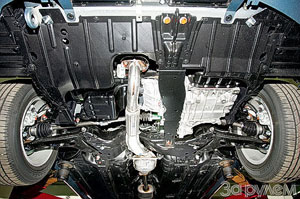 Cars with 1.3 engines were officially supplied to the Russian market; 1.6 and 2.0 liters (see the history of the model). The mechanics of these engines, like unofficial 1.5 and 1.8 liters, are quite reliable. If you change oils, filters and timing belt in time (be sure to the video!), Then you can not think about the capital with runs under 200 thousand km. The main problems arise with the periphery of the motor due to poisoning by surrogate fuel. Candle replacement may be required every 15 thousand km. The engine control unit refers to ignition passes very loyal - it lights Check Engine only after the third trip with the sneezing engine. Therefore, we recommend focusing on primary signs - uneven work on idle and failures during acceleration. It is better to leave platinum candles on the counter, they do not serve as long as they cost. In terms of price-resource ratio, the original MS851358 (150 rubles/pcs) are optimal.
Cars with 1.3 engines were officially supplied to the Russian market; 1.6 and 2.0 liters (see the history of the model). The mechanics of these engines, like unofficial 1.5 and 1.8 liters, are quite reliable. If you change oils, filters and timing belt in time (be sure to the video!), Then you can not think about the capital with runs under 200 thousand km. The main problems arise with the periphery of the motor due to poisoning by surrogate fuel. Candle replacement may be required every 15 thousand km. The engine control unit refers to ignition passes very loyal - it lights Check Engine only after the third trip with the sneezing engine. Therefore, we recommend focusing on primary signs - uneven work on idle and failures during acceleration. It is better to leave platinum candles on the counter, they do not serve as long as they cost. In terms of price-resource ratio, the original MS851358 (150 rubles/pcs) are optimal. We wash the nozzles through that - every 30 thousand km, preferably with dismantling, so as not to once again litter in
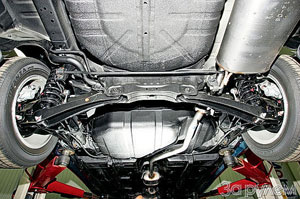 catalytic neutralizer. The age of the front and without this garbage is short-lived, cases of melting of honeycombs are known even on the 8th thousand! The neutralizer is nothery (32,000 rubles), therefore, when buying a used car, do not stir up for the diagnosis of electronic systems at the dealer (1200 rubles). By the difference in the readings of the anterior and rear oxygen sensors, you can indirectly judge the residual resource of the expensive part. If the diagnostic device (MUT-III) does not see the difference, then the neutralizer is not a tenant.
catalytic neutralizer. The age of the front and without this garbage is short-lived, cases of melting of honeycombs are known even on the 8th thousand! The neutralizer is nothery (32,000 rubles), therefore, when buying a used car, do not stir up for the diagnosis of electronic systems at the dealer (1200 rubles). By the difference in the readings of the anterior and rear oxygen sensors, you can indirectly judge the residual resource of the expensive part. If the diagnostic device (MUT-III) does not see the difference, then the neutralizer is not a tenant. Many owners, instead of the due gasoline AI-95, season the car ninety-second (it is less likely to fake it). Dealers do not approve of this, but do not punish in any way; Indeed, with a calm style of driving, such a transition does not threaten such a serious transition. Some transfer cars to gas (Digitronic DGI-EVOLUTION, costs about 28,000 rubles with installation), but such radicalism is already taking on hostility and instantly deprives the guarantee. And the owner has another problem - where to put the spare tire: after all, its place is occupied by a 43 -liter toroidal cylinder.
Weather dependence
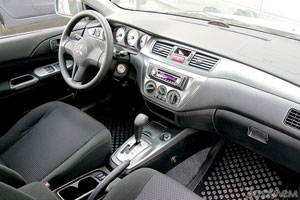 In general, electrical equipment does not cause trouble. The exception is the actors of the central rear door lock. Therefore, leaving the car in the parking lot, it is better to once again check if all the doors are closed. More often refusals arise in the winter due to frozen condensate. Alas, spray WD-40 and blow out with compressed air often late, the motor manages to burn.
In general, electrical equipment does not cause trouble. The exception is the actors of the central rear door lock. Therefore, leaving the car in the parking lot, it is better to once again check if all the doors are closed. More often refusals arise in the winter due to frozen condensate. Alas, spray WD-40 and blow out with compressed air often late, the motor manages to burn. The fat owners often sit seats, which is why heating elements are torn. This becomes known, of course, in the winter, but the cliff of the element often occurs in hot weather when the seats get wet, sorry, from sweat. The air conditioner is to blame, from which you can’t get a chilling coolness, so Lancers should be treated as a norm of such a feature of the microclimate. But even such a wimp is able to split the windshield, if it, red -hot by the sun, direct the entire stream of chilled air. In winter, do not rush to melt ice on glass: it is better to lose time than 19,000 rubles. (Glass with replacement). Protect the wiper remote control at the driver's door, it also costs a lot - 10,200 rubles. (non -original can be found for 1,500 rubles). He can refuse due to water from the key, for example, in the rain with open glass.
Let's take a word for a word?
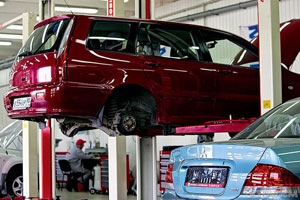 Since 2005, the plant changed the procedure for communication of electronic blocks. If earlier it was possible to restore the lost key only with the simultaneous replacement of expensive immobilizers and engine controller, now it is enough to fork out to the new keyboard.
Since 2005, the plant changed the procedure for communication of electronic blocks. If earlier it was possible to restore the lost key only with the simultaneous replacement of expensive immobilizers and engine controller, now it is enough to fork out to the new keyboard. Alas, neither before, nor after the modernization of electronics, a dealer diagnostic device (MUT-III) will confirm the honesty of the mileage of the machine: it sees only those numbers that are displayed on the instrument panel. The device will not tell about the trips of airbags, it will only determine the performance of the system with stingy yes or not. The main witness of the accident - the security system control unit is designed for one -time operation, like the rest of the components. Therefore, if MUT-III said yes, this does not mean that the car is unstable. Given the popularity of the model, when buying a used car, see both! As you know, the number of dubious offers in the market is growing with demand.
The history of the model
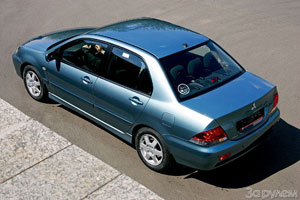 2003 presented the 9th generation of Mitsubishi Lancer. Body: sedan, station wagon (Wagon). P4 gasoline engines: 1.3 l, 60 kW/82 hp.; 1.5 l, 81 kW/110 hp.; 1.6 l, 72 kW/98 hp.; 1.8 l, 96 kW/130 hp.; 2.0 l, 99 kW/135 hp Front drive, M5 or A4 (InVECS II automatic transmission).
2003 presented the 9th generation of Mitsubishi Lancer. Body: sedan, station wagon (Wagon). P4 gasoline engines: 1.3 l, 60 kW/82 hp.; 1.5 l, 81 kW/110 hp.; 1.6 l, 72 kW/98 hp.; 1.8 l, 96 kW/130 hp.; 2.0 l, 99 kW/135 hp Front drive, M5 or A4 (InVECS II automatic transmission). Sports modification Lancer Evo-Lution VIII. P4 gasoline engines, 2.0 l: 195 kW/265 hp.; 206 kW/280 hp The drive is full (adjustable power flow along the axes with active differentials: rear AYC and the central ACD), M6.
2005 Light interior changes (other upholstery, design of the instrument panel, instruments with white scales), modification with climate control and leather steering wheel. Due to the new anticorus, sound insulation is somewhat improved. Another protocol of the exchange of electronic blocks. Sports modification Lancer Evolution IX.
2007 Detroit. The debut of the 10th generation models.
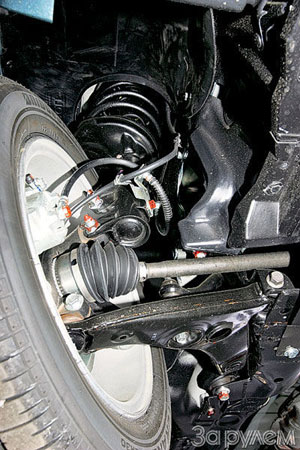
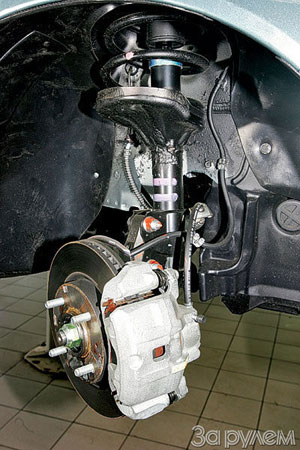

Igor Kozlov
Source: The magazine "Driving"



